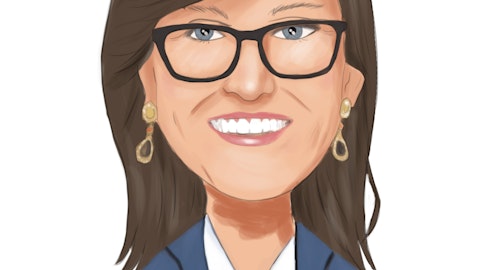Think of this as your go-forward rate. The team has done a really nice job driving that rate higher over time and will continue to do so. I think Cologuard provides really good value and we want to make sure that we’re getting paid fairly for that. What happened in the quarter was in part going back on tests that were previously denied payment on and making sure that we could get paid on that because, obviously, we have done the work. So pulling through revenue from past quarters, it wasn’t material in the quarter. I did call it out because it’s a nice contributor, but not a material driver. It was in the first half of the year, it’s over $10 million of revenue. When you compare that to the back half of the year, expect maybe $5 million of contribution.
So first half, second half, there is a dynamic there, but again, not material to Q2.
Operator: We’ll take our next question is from Patrick Donnelly with Citi.
Patrick Donnelly: Hey guys, thanks for taking the questions. Jeff, maybe one just on kind of the seasonality and pacing of the year. I think the guidance for 3Q assumes screening is kind of flat, maybe even slightly down. It’s been a weird couple of years with COVID in terms of seasonality of the business. Can you maybe just refresh us in terms of the typical pacing? Obviously, 4Q, you get the holidays into 1Q, but just feels a little conservative in terms of that 3Q guides. Maybe just talk us through that and how we should think about the year. Thank you.
Jeff Elliott: Yeah. Let me start with overall kind of what the seasonality should look like, and then we’ll get into this year specifically. So in a normal year, and this is a trend that’s really general to primary care, not necessarily Cologuard specifically, primary care trends typically start the year slow as people come back from the holidays. Early January, a few people go out and get — seek primary care. They’re typically busy with work in their lives after the holidays. And then throughout that first quarter, things pick up all the way through Memorial Day, things — people start to normalize care seeking behavior and really preventative care through that first part of the year. When Memorial Day hits, kids often get off of school and families take vacations, even people without kids often go on vacations.
So trends typically are a little bit softer, think of flattish trends throughout the summer. Then about mid-August, maybe end of August, things tick back up as kids come back to school and vacations start to wind down. So growth in primary care trends typically ticks back up then and ramp steeply through November and then with Thanksgiving, things slow down and are fairly quiet into the holidays. For Cologuard now, remember, there’s a — think of about a 30-day time frame from the time a test is ordered at the — during [indiscernible] doctor’s office to when then, it takes us then 30 days roughly to send the kit out, collect that patient sample, get the sample back in our lab, process it and recognize revenue. So that means that we follow a similar trend of typical primary care with a 30-day lag.
This year, the dynamic to think about, it really comes down to that COVID headwind I mentioned before. COVID headwind on that three-year rescreen business that I talked about a few minutes ago, that’s $50 million for the year. The biggest part of that, the single biggest quarter is Q3. Q2 picked up some. Q4 picks up some, but Q3 is the biggest. The other dynamic is that we did have a strong start to the year. I mentioned the kind of the ASP benefit over $10 million in the first half coming down to maybe $5 million in the second half. So that’s going to affect the seasonal trends this year. But if you take a step back further, you look at the overall guide for the year, we’re talking about $400 million of incremental growth for Cologuard. That’s for screening.
That is the biggest year we’ve ever had. In terms of percentage growth, you’re talking 28% growth at the midpoint. So very strong growth throughout the year for our screening business.



